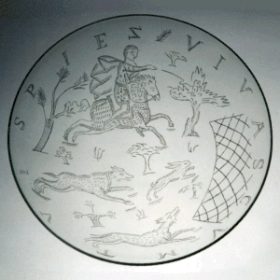

From the earliest times of glassmaking, vessels and objects have been worked, shaped and finished using various substances, notably stones of varying hardness. In Roman times, with the advent of free and mould-blown glassware, 'blanks' were passed from the glassmakers (vitrearii) to the engravers (diatretarii), who employed a wealth of cutting, scratching or abrading techniques. Glassmakers realised that the addition of even the simplest decorative feature frequently transforms a mundane piece into a much more desirable (and therefore more valuable) object. Inscriptions on some vessels are 'personalised' by the addition of the users' or recipients' names, which suggests that some engravings were especially commissioned by the purchaser. (see 068h and 071a in our Gallery).
Three particular techniques were widely used:
The vessels in this group can be dated to the first third of the 4th century AD. They were engraved by hand in a scratchy linear style using a sharp pointed tool, with outlines usually emphasised by short hatching strokes.

Although the bowls are usually referred to as the 'Wint Hill Group" most have been found in Germany, particularly around Cologne, and it seems likely that they were made and engraved there. The decorations fall into three main categories: hunting scenes, mythological characters and Biblical or Christian scenes. (The presence of the Chi-Rho symbol on several of the latter helps to date the whole group later than Constantine's conversion to Christianity). Stylistically, there appears to be only a small group of artists involved in the engraving. The Bonn stag hunt (068g), Nettersheim bear hunt (068k) and Lazarus bowl (070e- all in our Gallery) are probably by the same hand, and several other bowls show obvious similarities. Identical scenes are sometimes interpreted by different artists, indicating that, as in many other aspects of Roman art, they worked from prescribed design patterns.

We use a soda-lime glass of our own composition based on, and extremely close to glass from the Roman period. It is colourless with a greenish tinge. Our reproductions are engraved using mounted diamonds, following Pliny's description (see above). Although the use of a 'sharp-pointed tool of flint' has been suggested, in practise this proves to be less than satisfactory, imparting merely a slightly opaque abrasion to the surface of the glass, rather than a sharp cut. (Flint is used to produce the parallel bands on such vessels as the Bonn Cupids beaker (071a - see our Gallery). Hardened steel tools have also been suggested, but they too require considerable pressure in use, prove difficult to control, and need constant re-sharpening, thus there can be little doubt that the Roman diatretarii used diamonds or other hard stones. (Pliny, quoting Metrodorus of Scepsis, specifically mentions Germany as a source of the best diamonds:
These vessels each require many hours of careful preparation and engraving, and are priced to reflect the amount of time involved in their creation. Every vessel is numbered, signed and dated by us both, and includes a comprehensive description of the scene depicted. The engraving is highlighted in dark brown or black easily removed, water soluble ink.
When new, Roman glass had a shiny, "fire-polished" finish. The dull or iridescent surfaces that many of the surviving examples exhibit is due to the weathering processes to which they have been exposed since the Roman period. Our reproductions have the same fire-polished finish as the original glass would have had.
Please note that our reproductions are never more than c.20cms in diameter